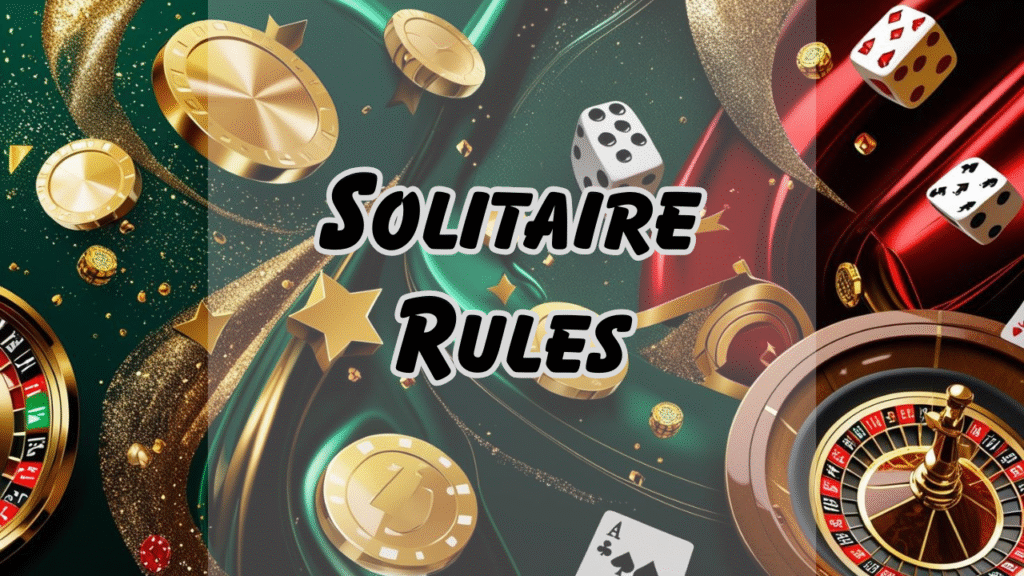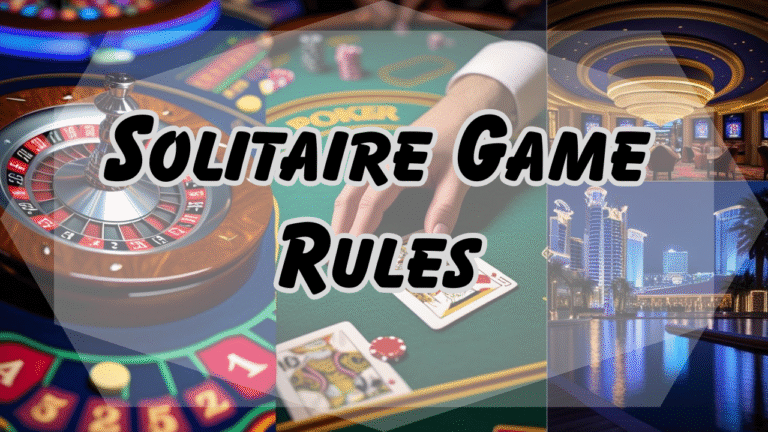Solitaire Rules, the classic one-player card game, has been a transgenerational phenomenon as much more than a passing diversion. Even with the advent of computer and online gaming, it has now re-surfaced as an entertainment as well as a brain-training device. Used either with a classic 52-card deck or on mobile and computer screens, Solitaire provides unforeseen cognitive advantages—improving memory, enhancing decision-making ability, and enhancing concentration.

This blog breaks down the fascinating 7 fundamental rules of Solitaire, highlighting the value of knowing and doing them with improved gameplay and mental acuity. If you’re looking for a refined tutorial of how it is to play Solitaire that’s both informative and practical, this is your ultimate guide.
Understanding Solitaire: A Brief Background
Solitaire, commonly known as “Klondike” in traditional format, is a single-player card game whose objective is to relocate every card to foundation piles, by suit and in ascending rank (Ace through King). It demands logical ordering, foresighted planning, and pattern awareness—attributes which have endeared it to strategists and general players alike.

First popularized in Europe during the 18th century, Solitaire became a global phenomenon with its computerized version built into initial Windows versions. Nowadays, it’s widely accessible on phone apps and websites and draws millions of visitors daily for its ease and brain-stimulating nature.
7 Basic Solitaire Rules to Remember
Knowing these basic rules not only improves your winning odds but also your analytical mind and patience.
1. Purpose: Form Foundations by Suit
Solitaire Rules: Your ultimate aim is to transfer all 52 cards to four foundation piles, which are begun with an Ace and end with a King, ranked by suit: Hearts, Clubs, Spades, and Diamonds.

2. Tableau Must Alternate Colors
Cards in the tableau (principal playing area) have to be placed in descending order and alternate in color (e.g., Red Queen on Black King). This rule promotes visual order and strategic thinking.
3. Kings Alone Can Populate Vacant Columns
When a tableau column is emptied, only a King (and its nicely ordered stack, if one exists) can be transferred to that position. This introduces some complexity that challenges players to think ahead in more than one move.
4. Stock and Draw Management
Every card that doesn’t make it into the tableau at the beginning is added to the stockpile. One or three cards at once can be drawn by players, depending on the variant. Using the stockpile efficiently usually makes for a win or loss.
5. Foundations Are Permanent
A card which moves to the foundation cannot be sent back to the tableau. This rule makes timing your moves and planning essential.
6. Always Try to Uncover Hidden Cards
Uncovering face-down cards in the tableau should be a priority. It increases your options and opens up more strategic paths.
7. Don’t Rush to the Foundation
Solitaire Rules: While it might be tempting to send cards to the foundation as soon as possible, it’s often wiser to keep them in the tableau to help uncover or build new sequences.
How to Play Solitaire in 5 Simple Steps
Step 1:
Shuffle the standard 52-card deck and the tableau is dealt out—7 columns, with cards increasing from left to right (1 to 7 cards). All cards in each pile are face-down except for the top card.
Step 2:
The remaining cards are placed in a draw pile (stockpile). The aim is to order all cards into the 4 foundation piles in ascending order.
Third,
In decreasing order, begin to arrange the tableau cards in alternating colors. For example, a red 6 on a black 7 is possible.
Step 4:
If you reveal an Ace, place it in a foundation. Build on it sequentially with the same suit.
Step 5:
Use your stockpile wisely to bring out more playable cards. Consider possible moves and don’t push cards to the foundation unless it’s worth it.
The Benefits of Playing Solitaire
Solitaire is more than a game—it’s a mental conditioning device. Here are the ways it helps those who play:
- Improves Cognitive Abilities: By making you memorize the locations of cards and patterns, it enhances short-term memory.
- Enhances Decision-Making Skills: You practice looking ahead and anticipating consequences before acting.
- Decreases Stress Levels: Its soothing, concentrated gameplay reduces stress levels, almost like a meditation practice.
- Teaches Patience: With few moves and much strategy, players learn to exercise better impulse control.
- Improves Productivity: Occasional breaks with Solitaire have been found to revitalize the mind, enhancing concentration upon return to work.
Frequently Asked Questions (FAQs)
Is there always a means of winning in Solitaire?
No, all games are not winnable. Statistically, approximately 80% of Solitaire games can be solved, but this varies with the original shuffle and strategy.
Can I undo moves in computer Solitaire?
The majority of computer games have an “undo” feature. But relying too much on it can diminish your natural decision-making skills.
How do I improve at Solitaire in the shortest amount of time?
Play repeatedly, observe patterns, and take your time in making moves—particularly on whether to transfer cards to foundations.
Is playing Solitaire healthy for my brain?
Yes. It encourages logical thinking, pattern recognition, and patience—both of which are important for mental well-being.
What is the most effective Solitaire strategy?
Avoid hastily transferring cards to the foundation, always reveal hidden cards first, and prioritize transferring cards from the tableau to the stockpile.
Final Thoughts
Solitaire is more than a nostalgia-filled past time—it’s a rich, strategy-laden game that rewards the mind with each play. By learning the basic rules and comprehending the game’s architecture, gamers can enjoy a sharper mind and a calmer state of concentration. Whether played while taking a break or unwinding after a long workday, Solitaire is still one of the most influential card games ever devised.

Now that you understand the rules—shuffle up, begin stacking, and let the mental magic start.
Drop me a line if you’d like a printable cheat sheet or visual guide to go along with this blog!



